The main element of the Russian bath is the heater-stove. It differs from a conventional heating device in a special container - a grid filled with stones. Water, falling on stones, breaks down into tiny particles and creates life-giving steam.
Technical requirements
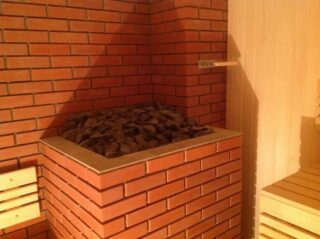
The sauna heater has several functions. It heats the steam room, maintains the room temperature and ensures that the right steam is produced. For a stove to fulfill these tasks, its design and installation must meet a number of stringent requirements.
- Maximum efficiency - the heater does not work for long. Therefore, it is more important to warm up the room as quickly as possible than to maintain the temperature for a long time.
- In the oven, the ash collection section should be located at a distance of at least 18 cm from the floor.
- The furnace body can also be metal. But in this case, a protective shield made of refractory materials enters around it. It is more profitable to immediately build a brick oven.
- The brick body is not a substitute for steam stones. It is important not only to evaporate the water, but to spray it into very small particles first. This requires flat stones, and with a special surface.
- Install the sauna stove at a distance of 55 cm from the wall. If the body is protected by a stone box, the distance is reduced. In addition, it is allowed to install a wood-burning stove built-in between the steam room and the dressing room. In this design, the doors of the firebox and ash pan are located on the side of the dressing room, which allows it to be heated from the outside.
- The steam room is finished only with wood, and this is a combustible material. To prevent fires, the floor around the stove is protected with asbestos or minerite sheets. This is how the wall is protected.
The oven can be combined with a water heating tank.
Types of stoves for a bath
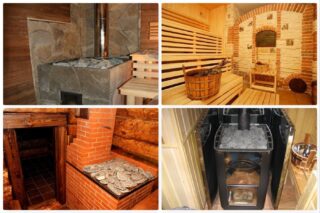
Stoves in a wooden bath are classified according to a variety of criteria. For example, there are models of constant and periodic furnaces. The first ones give rather hard steam, since here stones, even on a flat surface, do not heat up above +350 C. The model of a periodic furnace heats only a steam room. Here the stones are warmed up not only due to heating, but also due to the passage of hot gas through the grate. At the base of the stone slide, the temperature can reach 1100 C, so the steam here turns out to be soft - finely dispersed and does not obstruct breathing.
By material
The body of the device is made of two main materials: metal alloy and brick.
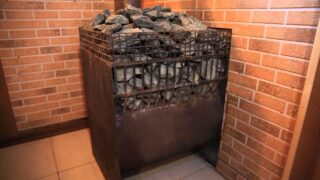
Metal alloy - special heat-resistant steels and cast iron. Such structures attract with their low weight, compactness with very high efficiency, quick warm-up - a medium-sized steam room is heated in 1 hour. In addition, iron stoves can be beautifully and unusually decorated.
However, such a project has a lot of disadvantages. The metal quickly gives off heat, but does not retain it either: the oven cools instantly, and the temperature in the room jumps sharply. The cabinet gets very hot, which poses a danger to the wood-trimmed room. More often than not, the heater has to be surrounded by a protective screen and its design becomes unimportant.
A self-made iron stove according to a finished drawing is the most budgetary option.But its effectiveness is low.
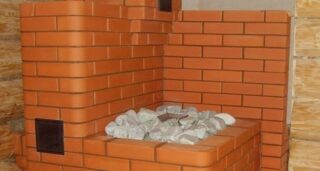
Heat-resistant brick stove heats up the room more slowly - up to 6 hours, but it maintains the temperature in the steam room after the end of the firebox for at least 2 hours. The stone heats up less, so the risk of fire is much lower. A brick oven can heat a room with an area of more than 30 m². Its durability is much higher than its iron counterpart.
The disadvantages include a lot of weight: you will have to build your own foundation for the stove. Laying it is difficult, requires experience, it is more difficult to care for it. And the size of the stove is quite fair.
If a metal stove is sealed with a brick barrier, the overall dimensions are comparable to a brick stove.
By type of fuel
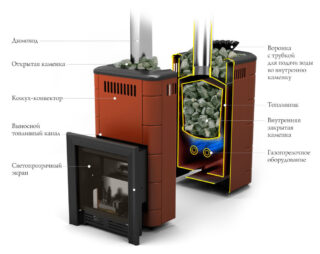
The stove in the steam room is classified according to the type of fuel:
- wood - the most popular, since the cost of firewood is the lowest;
- coal - it is less common, since coal gives a higher temperature and it turns out to be much more difficult to control the heating of the room;
- gas - this is allowed to be installed only with a special permit;
- electric - is more common in home saunas and attracts with high fire safety, but it is expensive to maintain.
The safest in the steam room is a wood-burning stove.
Selection principles
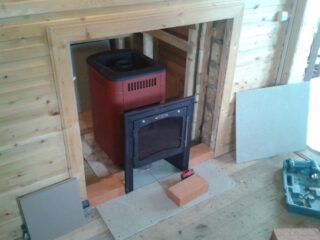
The criteria are as follows:
- power - determined by the size of the steam room and the number of users;
- material - today chromium steel is considered the best option, since it reduces oxygen burning;
- the type of firebox is elongated, that is, the stove is mounted between the steam room and the dressing room, and the usual closed one;
- heater type - plane, mesh next to the body, screen around the body and part of the chimney;
- the duration of operation with one tab is determined by the design features of the furnace;
- heating rate - a "hot" oven heats up a room in a couple of hours, but cools down quickly, a "cold" oven keeps the temperature.
Other criteria are also important, such as the presence of a water heater, protective devices that prevent carbon monoxide from entering the room, operating modes, performance and convenience of kindling.
Popular models and prices
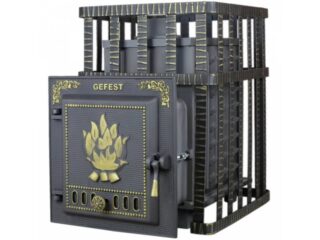
The selection of ovens on the market is huge. However, for a bath, it is preferable to purchase models from domestic manufacturers, since their products are adapted to existing conditions.
- Harvia - produces both conventional floor models and wall and corner models. The main material is high strength steel. The body is coated with a special fire-resistant paint. Models cost from 14 thousand rubles.
- Helo - most of the models are made of stainless steel, which guarantees a long service life. A characteristic feature is a heat-resistant glass insert that allows you to observe the flame. The cost of electric heaters starts from 40 thousand rubles.
- "Termofor" - produces heaters for the Russian steam room mode. Offers a huge selection of models of different capacities and designs. Heat-resistant chrome steel is used for the firebox. Models cost from 23 to 45 thousand rubles.
- "Gefest" - offers cast iron models for a bath with the highest efficiency - up to 90%. The stoves are very economical and provide light steam. The minimum cost is from 50 thousand rubles.
Cast iron stoves are installed much less frequently. Despite the fact that such a structure retains heat for a long time, it is very heavy.
The foundation for a brick stove-heater
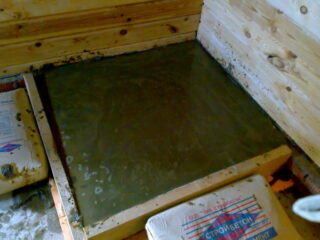
For a brick or cast iron stove weighing more than 700 kg, you need to make your own base. The foundation is chosen according to the mass of the structure and the nature of the soil.
Concrete foundation
This option is built for a small heater. You can use not only rubble stone, but also brick. The step-by-step instructions are simple.
- A pit is dug, the dimensions of which around the perimeter are 15–20 cm larger than the dimensions of the furnace.
- A sand cushion is laid at the bottom, waterproofed. Formwork boards are placed on the walls.
- Lays out layers of rubble and fills the voids with rubble.The thickness of the layer does not exceed 15–20 cm. The quarry is poured with a thin layer of cement.
- After the solution has solidified, lay out the second layer of stone. The cement mortar is applied again. The operation is repeated until the pit is filled.
The fragment is not brought to the edge of the formwork by 7–8 mm. Cover it with roofing material on top and fill it with bitumen.
Foundation slab on piles
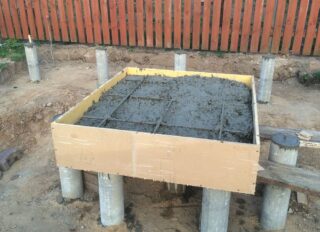
The pile foundation is built on fill and swampy soils. For piles, steel or concrete rods are taken.
Step by step guide:
- Holes for piles are drilled in the corners of the site. A layer of sand and crushed stone 15–20 cm thick is compacted to the bottom.
- Roll up a roll of roofing material, insert it into the recess.
- Piles are driven into the ground.
- Formwork is built, reinforced and poured with concrete. The thickness of the slab is at least 20 cm.
Using the same technology, a foundation is erected on columnar bases.
Monolithic foundation
Such a solid base is provided for the casings of heavy furnaces. It is not difficult to make the foundation, but more materials will be required.
- Dig a pit according to the dimensions of the furnace plus 15 cm around the perimeter. Fill in 15 cm of sand and tamp the bottom.
- The pit is covered with expanded clay and covered with a film or roofing material.
- Formwork is made. Place inside the reinforcement made of rods, 10 mm thick, connected with steel wire.
- The pit is poured with concrete, compacted with a vibrator.
The concrete dries in about 3 weeks. At this time, the surface of the foundation must be moistened with water and covered with a film.
Materials and tools
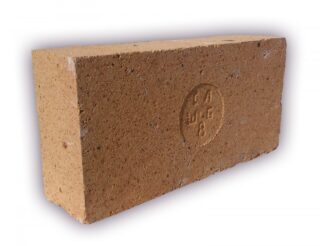
To build a brick heater you will need:
- refractory brick - better fireclay, for laying out the firebox;
- facing for the body;
- steel chimney of the required diameter;
- doors for the firebox and ash pan, cast iron grate;
- clay mortar for masonry;
- trowel, hammer;
- level, slope, tape measure.
You will also need a waterproofing material, mesh or steel sheet for stones.
DIY making
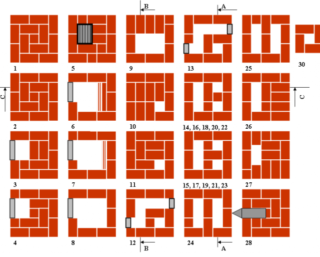
The laying of a stove in a sauna differs little from the construction of a conventional one. It is important to carefully follow the order and act according to the developed scheme.
- The foundation is waterproofed: 2 sheets of roofing material are laid with an overlap of 10 cm. Bitumen is not needed.
- The first row is always solid. Fix the bricks with masonry mortar.
- On the 2nd and 3rd rows, a pan for ash and a channel for air exchange are laid.
- From 4 to 6, the internal walls of the firebox are laid out of fireclay bricks, the grates are installed and the doors are mounted. For the doors, hinges are laid in the masonry.
- At 8 and 9, the supports for the grid-heater are mounted. In this capacity, sections of a profile or T-beams are used.
- From 13 to 15, revision holes and holes for steam outlet are formed.
- During masonry, each odd row is checked by level to ensure that it is horizontal. Every 2-3 rows, wire is laid in the seams to strengthen the structure.
It is recommended to lay the brick dry, and only then put it on the mortar.
All fittings are mounted simultaneously with the masonry. For winding the doors, it is advised to take an asbestos cord.
Water tank
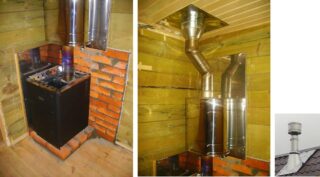
The bath offers 2 variants of the water heater.
- Tank for the chimney - as the steel pipe heats up to +500 C. The water in the tank also heats up very quickly. At the same time, heat from the escaping heated gases is not lost, and the chimney itself functions longer, since it gives off excess heat to water.
- Hinged - mounted on the wall inside the steam room. The tank is heated from the heater body, and the water is piped to the sink. Less economical model.
It is undesirable to put a hinged tank in the sauna, since water vapor enters the room.
Possible mistakes
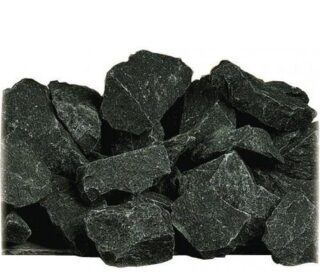
The sauna heater will function for a long time and correctly if certain recommendations are followed during its arrangement.
- It is better to take clay red brick for laying the hull. Only fireclay is suitable for the firebox, replacement is unacceptable.
- It is important to choose the correct consistency of the clay mortar for the masonry.If it is too dry and liquid, the masonry will crumble, too greasy - the joints will be loose.
- Not every stone is suitable for a heater. Choose basalt, talcochlorite, andesite.
- The stones are selected in a relatively flat shape and placed in an upright position. When placed horizontally, heat is distributed unevenly.
Trial ignition is performed after the masonry has completely dried, it lasts no more than 5 minutes. Within 3 days, the procedure is repeated several times a day. Only after that they begin to fully heat the steam room.








